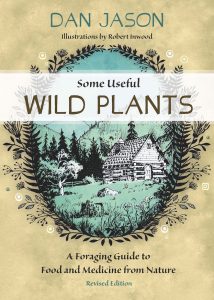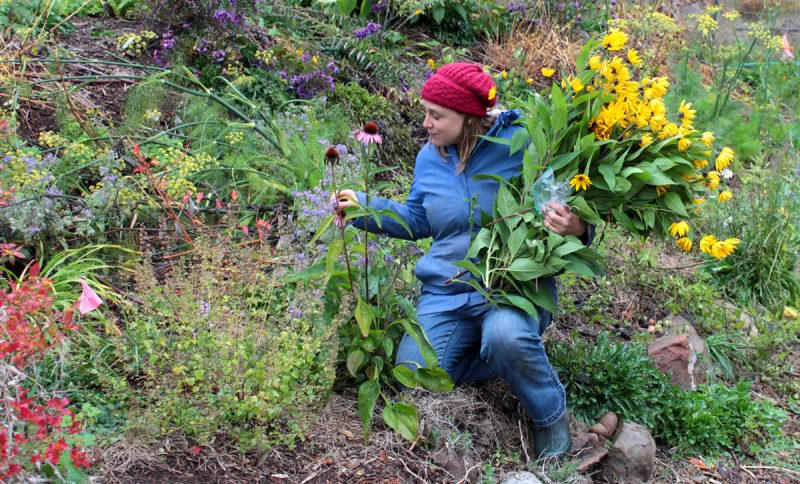#169 A hero in the garden
Some Useful Wild Plants: A Foraging Guide to Food and Medicine from Nature
by Dan Jason
Madeira Park: Harbour Publishing, 2017
$16.95 / 9781550177916
Reviewed by Natasha Lyons
First published Sept. 13, 2017
*
 Reviewing a book published before you were born is an interesting historical exercise. Dan Jason’s Some Useful Wild Plants: A Foraging Guide to Food and Medicine from Nature led me to reflect on the social sense of the time, the way that science was practiced, and how knowledge first imparted since the book’s appearance in 1971 has translated across the space of four and half decades.
Reviewing a book published before you were born is an interesting historical exercise. Dan Jason’s Some Useful Wild Plants: A Foraging Guide to Food and Medicine from Nature led me to reflect on the social sense of the time, the way that science was practiced, and how knowledge first imparted since the book’s appearance in 1971 has translated across the space of four and half decades.
Jason wrote the first edition of this guide in response to the lack of comparable resources for the forest-wanderer. It has since sold over 30,000 copies in six printings.
A transplant himself from out east, Jason lived many years in the Slocan Valley before starting Salt Spring Seeds on the Gulf Island of the same name thirty years ago, a company that now actively grows over 700 wild and domestic plants for seed (p. 8).

Jason’s guide is usefully divided into easy categories — herbs and shrubs, berries, seaweeds, trees, and poisonous plants — organized alphabetically within by common name. Some of the plants described are species-specific, others are at the genus or family level.
The writing is accessible and engaging. Each entry starts with a description of the plant and its ecology followed by an account of its use in foods, beverages, technologies and medicines. The illustrations produced by Robert Inwood are folksy and charming and, while black and white, give a good sense of these plants’ structure and environment. They assist with practical identification in the field.
Jason provides plenty of valuable knowledge and practical applications. For instance, did you know that balsamroot seeds (Balsamorhiza sagittata), when toasted and ground, taste like popcorn (p. 14)? Or that seaweeds can be used as an ingredient in liquor (p. 128)?

Willow (Salix spp.) — widely known as a pain reliever — can also be used as a medicinal substitute for quinine (p. 151), but you should avoid ingesting any part of the very beautiful perennial Pacific bleeding heart (Dicentra spp.), which contains an alkaloid that causes convulsions (p. 168).
Jason accrued his information from various sources. For the original volume, he consulted “First Nations herbalists and Doukhobor wildcrafters,” published works, a network of plant-lovers (p. 8), as well as sharing a great deal of his own well-earned practical knowledge — and that of his partner, apparently, as there is liberal use of the pronoun “we” in the text.
It is not clear what revisions there are to this edition. It may just be the new introduction, which among other things expresses the author’s appreciation and amazement at the continued success and utility of Some Useful Wild Plants.
To understand the original impact of the 1970s edition, I consulted Cedana Bourne of the Galiano Conservancy, who remembers purchasing a secondhand copy in the early 1990s. At the time, she was amazed by the knowledge in this guide, which was still one of a few in its genre. She told me it was foundational to her learning about coastal plants.

Jason’s volume was even more anomalous in the early 1970s when it was first published, but it was part of the leading edge of an era of active ethnobotany in British Columbia whose fervour has continued to the present. Nancy Turner’s seminal Food Plants of Coastal First Peoples would be published in 1975, followed by companion volumes in the Royal British Columbia Museum series. Tilford’s Edible and Medicinal Plants of the West, a clear descendant of both these books, was published in 1997.
Like these guides, Jason chose his “useful wild plants” for their utility (or in the case of poisonous plants, the opposite) to different harvesters, ubiquity on the landscape, and wildness.
Though unstated, Jason clearly means “wild” to refer to plants that are either native or naturalized to North American forests. Many of these latter plants, such as mullein (Verbascum thapsis), chamomile (Chamaemelum nobile; note that Matricaria spp. and several other asters growing in the Northwest are also called chamomile), and alfalfa (Medicago sativa) are very useful plants with foreign origins.

Inwood’s whimsical drawing of alfalfa (Figure 1) shows it growing (wild or sowed?) near a farmstead and being munched on by a cow; this plant was introduced to North America from Eurasia.
As with society itself, plant guides have become more scientific in the past many decades, and in his introduction Jason refers to the scores of glossy plant guides now available. Pojar and MacKinnon’s Plants of the Pacific Northwest Coast, first published in 1994, and companion volumes in Lone Pine’s series, are perhaps the flagships of this form.
These guides provide distribution maps, excellent photographs, and detailed information on habitat, ecology, and use.
For the weekend hiker, modern-day wild-crafter, and plant researcher alike, such guides are absolutely indispensable, and Jason’s guide is best used alongside them when making identifications, particularly because illustrations are only provided for about half of his plants.
Curious and serious plant researcher types can consult amazing digital resources such as the Eflora B.C. Atlas (http://ibis.geog.ubc.ca/biodiversity/eflora/) for access to multiple photographs and information on nomenclature, herbarium records, and relevant databases.
Scientific study has advanced plant knowledge on myriad fronts since the 1970s. DNA analysis, for instance, has shifted our knowledge of the taxonomy and distribution of wild plants in the Northwest and beyond. While unimportant to the general user, plant researchers will need to know that red and blue elderberry (Sambucus spp.) have been moved from the valerian (Caprifoliaceae) to the honeysuckle (Adoxaceae) family, blue and common camas (Camassia spp.) from the lily (Liliaceae) to the asparagus (Asparagaceae) family.

Genetics, archaeology, and First Nations knowledge have led to our recognition that present-day plant distributions are heavily influenced by pre-contact and historic range extension by Indigenous communities that transplanted, cultivated, and traded food and technological plants heavily and widely throughout British Columbia and the Pacific Northwest, including camas, hazelnut (Corylus cornuta), and various edible berries (Armstrong 2017; Lyons and Ritchie 2017; Turner 2014).
I was not familiar with this book until now and was captivated by its charming cover, easy style, and the depth and novelty of the knowledge shared in its pages. I learned much from reading this B.C. back-to-the-land and forest-wanderer classic and will enjoy having it on the trail with me.
I know that the plant community of B.C. will join me in congratulating Dan Jason on the staying power and continued relevance of Some Useful Wild Plants.
*

Natasha Lyons is an ethnobotanist, palaeoethnobotanist, and archaeologist. She lives with her family in the Ponderosa pine zone of B.C.’s North Okanagan, and can often be found exploring the flora and fauna of the provincial park that borders their home. Natasha and her husband Ian own and operate Ursus Heritage Consulting, and work with First Nations and Inuit communities across Western Canada. Natasha is Adjunct Faculty in the Department of Archaeology at Simon Fraser University, where she did both her Master’s and post-doctoral studies. She publishes widely on community-based practice, critical archaeology, and the many amazing ways and means that Indigenous First Peoples have used plants in the past and present.
*
References—for more information
Armstrong, Chelsey Geralda
Historical Ecology of Cultural Landscapes in the Pacific Northwest. Unpublished PhD Dissertation, Department of Archaeology, Simon Fraser University, Burnaby, 2017. Soon available on SFU Library at: www.lib.sfu.ca
Klinkenberg, Brian, Ed.
E-Flora BC: Electronic Atlas of the Flora of British Columbia [eflora.bc.ca]. Lab for Advanced Spatial Analysis, Department of Geography, University of British Columbia, Vancouver, 2017. Website accessed: 12 July 2017.
Lyons, Natasha and Morgan Ritchie
“The Archaeology of Camas Production and Exchange on the Northwest Coast: with Evidence from a Sts’ailes (Chehalis) Village on the Harrison River, B.C.” Journal of Ethnobiology (2017) 37(2): 346-367.
Pojar, Jim and Andy MacKinnon, eds.
Plants of Coastal British Columbia including Washington, Oregon and Alaska. BC Ministry of Forests and Lone Pine Publishing, Vancouver, 1994.
Tilford, Gregory
Edible and Medicinal Plants of the West. Mountain Press Publishing, Missoula, Montana, 1997.
Turner, Nancy
Food Plants of Coastal First Peoples. Royal British Columbia Museum Handbook. First edition 1975. UBC Press, Vancouver, 1995.
Turner, Nancy
Ancient Pathways, Ancestral Knowledge: Ethnobotany and Ecological Wisdom of Indigenous Peoples of Northwestern North America, Volume 1 (2014). McGill-Queen’s University Press, Montreal & Kingston.
*
The Ormsby Review. More Readers. More Reviews. More Often.
Reviews Editor: Richard Mackie
Reviews Publisher: Alan Twigg — BC BookWorld / ABCBookWorld / BCBookLook / BC BookAwards / The Literary Map of B.C. / The Ormsby Review
The Ormsby Review is a new journal for serious coverage of B.C. literature and other arts. It is hosted by Simon Fraser University. The Advisory Board consists of Jean Barman, Robin Fisher, Cole Harris, Wade Davis, Hugh Johnston, Patricia Roy, David Stouck, and Graeme Wynn.
“Only connect.” – E.M. Forster